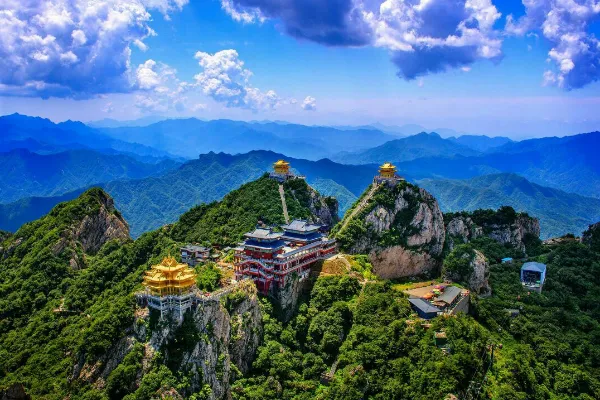
Located in western Nanyang City, Henan Province, spanning Xixia, Neixiang, and Xichuan counties, Funiu Mountain is a national 5A-level tourist attraction, UNESCO Global Geopark, and national nature reserve. Covering approximately 1,000 square kilometers with its main peak (Jijiaojian) at 2,212.5m (the highest in eastern Qinling Mountains), it's renowned for rich geological relics, intact ecosystems, and unique landscapes, honored as "Central China's Green Lung" and "Natural Gene Bank of Flora and Fauna."
History and Culture
Formed 800 million years ago in the Neoproterozoic era, Funiu Mountain is crucial to China's Central Orogenic Belt. Designated a UNESCO Global Geopark in 2006, its coexistence of granite and karst landforms is globally rare.
The area is deeply cultural - a cradle of Chu-Han culture, with ancient temples like Yunyan Temple (Northern Wei) and Danxia Temple (Tang), plus numerous cliff inscriptions and poems.
It's also a revolutionary base where leaders like Li Xiannian and Wang Shusheng operated during anti-Japanese and liberation wars.
Main Attractions
Laojie Ridge
The 2,212.5m main peak area features spectacular peaks and seas of clouds, known as the "Yangtze-Yellow River Divide," with highlights like Immortal Peak and Jade Emperor Summit.
Longtangou (Dragon Pool Valley)
Famous for its 19 waterfalls and 72 pools along 12km, including the 35m "Dragon Pool Waterfall." With 98% forest coverage, it's an ideal summer retreat.
Baotianman
This national nature reserve preserves intact north-subtropical forests, housing 2,911 plant and 359 animal species ("Natural Gene Bank"). Features virgin forests, alpine meadows, and cloud seas.
Dinosaur Relics Park
In Xixia County, this world's largest dinosaur egg fossil site (100,000+ eggs discovered) includes museums and animatronic displays for prehistoric exploration.
Laojun Mountain
One of Funiu's three main peaks (2,192m), traditionally where Laozi meditated, boasts glorious Taoist temples atop clouds, making it a sacred Taoist site.
Cuisine
Xixia Mushrooms
As China's "Mushroom Town," Xixia offers thick, flavorful mushrooms in dishes like stewed chicken with mushrooms.
Danjiang Fish
Wild fish from Danjiangkou Reservoir, best enjoyed as "Danjiang Fish Head Soup" - tender with rich broth.
Wild Mountain Vegetables
Local wild mushrooms and edible plants like fiddleheads served cold, stir-fried, or stuffed with unique flavors.
Local Delicacies
Nanyang City (1.5-hour drive) offers Henan specialties like stewed noodles, spicy soup, and mutton soup.
Ticket Information
Varies by site: Laojie Ridge 90 yuan, Longtangou 80 yuan, Baotianman 70 yuan, Dinosaur Park 90 yuan, Laojun Mountain 100 yuan. Seniors (60+) and students get 50% discount with ID. Children under 1.4m free.
Opening Hours
Generally 7:30-17:30 (peak season April-October), 8:00-17:00 (off-season). Allow half-day to one day per site.
Recommended Tour Route
3-day itinerary: Day 1: Dinosaur Park → Longtangou Day 2: Laojie Ridge summit for sunrise clouds Day 3: Baotianman virgin forest → Return Customize based on time and interests.
Transportation
- Self-drive: From Zhengzhou via Zheng-Luan Expressway to Luanchuan/Xixia exits, then provincial roads
- Bus: Tourist shuttles from Nanyang Bus Station
- High-speed rail: To Nanyang East Station, then transfer to scenic area shuttles
- Air: Nearest airport is Nanyang Jiangying (2-3 hours to main sites)
Must-See Attractions
- Laojie Ridge: Summit Funiu's highest peak for sunrise clouds
- Longtangou: Marvel at waterfall clusters and pools
- Baotianman: Explore pristine forest ecosystems
- Dinosaur Park: World's largest dinosaur egg fossil site
- Laojun Mountain: Taoist culture and golden summit views
Travel Tips
- Plan 2-3 days for multiple sites
- Pack rain gear and layers for changeable mountain weather
- Wear comfortable anti-slip hiking shoes
- Photographers: bring wide-angle lenses and tripods
- Protect environment - no picking plants/animals
- Book accommodations early during peak seasons
Precautions
- Some high-altitude areas may cause altitude sickness
- Stay in designated areas
- Preserve cultural relics - no carving on rocks
- No smoking (fire prevention)
- Secure belongings in crowded areas
- Suspend hiking in severe weather